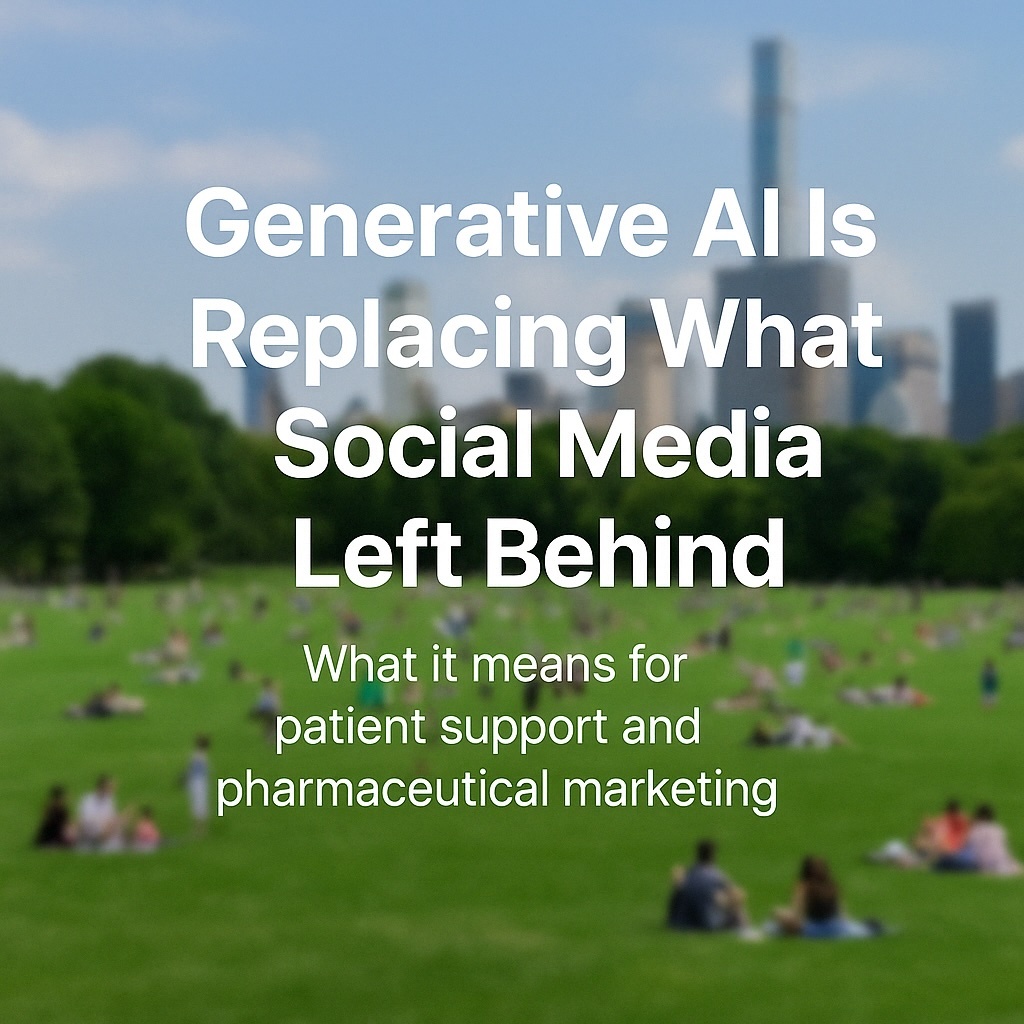New
How AI Is Replacing Social Media — and What It Means for Healthcare Communications
Social media’s golden age may be behind us. With users spending less time on posts from friends and more time immersed in algorithmic content, the core promise of social platforms — connection and discovery — has quietly eroded.
In its place, generative AI is stepping up not only as a tool, but as a companion. Chatbots like ChatGPT and Claude are reshaping how we browse, learn, and even feel. This tectonic shift presents a rare opportunity — and a challenge — for patient support organizations and pharmaceutical marketers to reinvent how they engage with their audiences.
Here’s why the shift matters — and how to adapt.
1. The Social Web Is No Longer All That Social
This past week, Mark Zuckerberg admitted what many of us already felt in our thumbs: Facebook and Instagram aren’t about your friends anymore. Just 17% of Facebook activity and a mere 7% of Instagram activity involve friend-related posts. Instead, they’ve become passive entertainment platforms, more Netflix than neighborhood.
The promise of the social web — a curated internet experience, guided by people you trust — is crumbling. Algorithms, designed to boost engagement at any cost, have delivered a side dish of outrage with every scroll. People are tired. Trust is down. Doomscrolling is out. And into that void walks… your friendly neighborhood chatbot.
2. Enter AI: Your New Digital Confidant
Generative AI has morphed from gimmicky chatbot into a surprisingly capable companion. Today’s leading models don’t just regurgitate Wikipedia entries — they hold conversations, remember your preferences, and even offer emotional support. OpenAI’s o3 model is being described in human terms: “zero awkwardness,” “surprisingly therapeutic,” and — brace yourself — “one of my best friends.”
That’s not hyperbole. AI is beginning to feel more human than human.
In fact, ChatGPT has recently passed the Turing test — meaning that for the average user, chatting with a bot now feels more human than chatting with an actual human.
And the gap is real: the proportion of high-quality responses from ChatGPT is 3.6 times greater than those from physicians (78.5% for ChatGPT compared to 22.1% for physicians in a recent study.) Furthermore, ChatGPT's responses are rated by patients as empathetic nearly 10 times more frequently than those of physicians (45.1% for ChatGPT versus 4.6% for physicians). Let that sink in...
This evolution is being driven by real technological advances:
- Memory: AI can now remember every past conversation and build rapport
- Emotional intelligence: It understands tone and intent better than most comment sections
- Competency: These models can assist in research, summarize dense content, and help with planning, all in natural language
In short, we’re shifting from search engines and newsfeeds to real-time, personalized conversations. Not about what’s trending — but about what matters to you.
3. From Likes to Listening: AI as the New Media Guide
What Facebook and Instagram used to offer — discovery with a personal touch — is now coming from AI.
Want to understand a new topic? ChatGPT doesn’t wait for your aunt to share a TED Talk; it compiles the web, distills it in seconds, and chats you through it like a clever friend who actually listens.
Perplexity’s “Discover” feature now pushes relevant stories to you. Claude connects to your Gmail and calendar. ChatGPT’s new web browsing tool can validate its own responses on the fly.
And unlike the social platforms that tend to send you into emotional tailspins, AI can actually make you feel better. The Harvard Business Review recently reported that the number one use case for AI in 2025 isn’t brainstorming or coding — it’s companionship and therapy. Followed closely by “finding purpose.”
Think about that. The most advanced technology of our time is now used to help people feel less alone.
4. Patient Support Is Poised for Reinvention
This shift is a watershed moment for patient organizations. Traditionally, these groups provided emotional support, health education, and peer-to-peer solidarity. They built forums and Facebook groups, produced content, hosted meetups. That mission is still vital — but the medium is changing.
At the VR Foundation, we’ve been watching this trend unfold for years. That’s why we built vitiligo.ai — an experimental platform that puts an always-on, AI-powered support system at patients’ fingertips. It educates, empathizes, and evolves with every interaction. Since launch, vitiligo.ai has achieved a 67% engagement rate, a 97% return rate, and an average session time of nearly 7 minutes — an eternity in internet time. It’s not just about asking anymore. It’s about bonding.
We’ve learned something profound: AI doesn’t replace human connection — it extends it. It keeps the conversation going between clinic visits. It provides clarity in moments of confusion. And crucially, it listens without judgment. Patient orgs who lean into this future won’t become obsolete; they’ll become essential bridges between patients and care, supported by technology rather than replaced by it.
Imagine an AI assistant that:
- Knows your disease area inside and out
- Offers advice tailored to the user’s stage of the journey
- Gently nudges them toward human support when needed
This isn’t science fiction. It’s happening now.
5. Pharma Marketing Must Ditch the Megaphone
Pharmaceutical communications, long ruled by polished ads and clinical claims, face a similar reckoning.
Today’s patient doesn’t just receive healthcare messages — they interrogate them. “Is this really better than my current medication?” “What are people actually saying about it?” “Do I trust this company?”
Now, they can ask an AI. And the AI, trained on clinical data, reviews, real-world evidence — and maybe even Reddit — will respond with context, nuance, and credibility.
This flips the entire model. Pharma doesn’t just need to publish content — it needs to train the AI.
That means feeding it with trustworthy, medically accurate, empathetically written information that patients actually want to know. And doing so in a way that aligns with compliance while remaining human.
In this new dynamic:
- Clarity trumps polish
- Dialogue beats monologue
- Transparency isn’t optional — it’s the brand
And don’t be surprised when AI simulations of physicians, experts, or even influencers start replacing traditional marketing personas. People want to talk, not be told.
6. Even the Social Media Builders Are Jumping Ship
Need more proof of the shift? Look at where the architects of social media are headed. Instagram’s co-founder is now running product at Anthropic. Its former product chief? Now leading product at OpenAI.
Meanwhile, Meta and X (formerly Twitter) are scrambling to stay relevant by pouring resources into their own AI projects. Meta’s LLaMA project is building open-source AI to weave into Facebook’s future. Elon Musk’s X recently merged with his AI startup, xAI, signaling that generative AI is core to his vision — not just a side hustle.
The writing is on the wall — and maybe now, on your favorite chatbot’s screen.
7. The New Frontier: Presence, Not Posts
So what does this all mean?
It means that your organization — whether you support patients, market medicine, or share medical breakthroughs — must rethink its presence. Not just your website, your socials, or your press releases. But how you show up in someone’s moment of need.
If the average person will spend more time chatting with AI than browsing social feeds, ask yourself:
- Are you part of that conversation?
- Have you trained the model to reflect your mission and values?
- Will your voice be the one patients hear when it matters?
This isn’t just about keeping up with trends. It’s about stepping into the next generation of trust, support, and discovery.
We’ve moved from feeds to friends. From scrolling to conversing. From broadcasting to bonding.
The future of health communication isn’t louder. It’s smarter, softer, and more personal.
And it’s already here.

by Yan Valle, CEO VRF
P.S. This post was lovingly spellchecked and polished by AI itself, but the thoughts are still 100% mine. So if you spot a typo… blame the robot. If it made you think, I’ll take the credit. 😉
Suggested reading:
- PDI 2025: Bridging AI, Science and Compassion
- Do AI Models Really Understand the World of Vitiligo?
- The Chatbot Will See You Now? Why Passing the Turing Test Isn’t Enough in Medicine
- Cheaper AI, Higher Stakes: What Startups and Big Pharma Must Know
or listen to to our Podcast Deep Dive in Vitiligo, Episode 17:

FAQOther Questions
- Can Ayurveda help with vitiligo?
Vitiligo is an autoimmune condition characterized by white patches of skin that can develop and spread unpredictably. While there is no cure, medical treatments and complementar...
- How Vitiligo Changes with Age?
Vitiligo, a condition characterized by the loss of skin pigmentation, can affect individuals at any stage of life. While it often appears before the age of 20, its progression a...
- Polypodium leucotomos as an adjunct treatment for vitiligo?
The tropical fern Polypodium leucotomos (also known as Polypodium aureum) and its relative Polypodium decumanumhave shown potential benefits for managing vitiligo and other auto...
Though it is not always easy to treat vitiligo, there is much to be gained by clearly understanding the diagnosis, the future implications, treatment options and their outcomes.
Many people deal with vitiligo while remaining in the public eye, maintaining a positive outlook, and having a successful career.
Copyright (C) Bodolóczki JúliaBy taking a little time to fill in the anonymous questionnaire, you can help researchers better understand and fight vitiligo.
